This post may contain affiliate links. If you click on one and purchase something, I may receive an affiliate commission — at no extra cost to you.
When I shared that I was going to the Land of the Thunder Dragon, a friend asked, what’s the process for a Bhutan visa? Well, you pay a shit load of money, I replied. And that’s the first thing you need to know about visiting Bhutan. (Unless you’re an Indian, Bangladeshi, or Maldivian national, in which case, lucky you.) Here’s everything else you need to know about visiting Bhutan.
Table of Contents
How much it costs to visit Bhutan
In almost every conversation about visiting Bhutan, the topic of cost will come up.
This is because every foreigner except for Indian, Bangladeshi, and Maldivian nationals must visit Bhutan with a licensed tour operator and purchase the minimum daily package. (The only other way around it is to have a Bhutanese friend and be granted a visa through them.)
For the high season months of March, April, May, September, October, and November, this amounts to $250 per person per night, with an additional $40 per night surcharge for solo travelers and $30 per person per night surcharge for groups of two. For the other months of the year, the base charge is $200 per person per night. The same surcharges apply.
Compared to the relatively cheap daily costs of neighboring countries like Nepal and India, this initially shocks many potential visitors. It certainly shocked me, both in that comparison and when compared with my typically budget-friendly travel style (ex: my Portugal & Spain trip was ~$50/day).
However, upon further thought, you’ll see that it’s comparative to traveling and staying in hotels in western Europe and in the United States, especially given that the costs cover almost everything once you’re in Bhutan.
The minimum daily package, which is set by the Royal Government of Bhutan in U.S. dollars, covers the following:
- Hotels (minimum 3 stars, you can upgrade to 4- and 5-star options)
- All meals
- A private, licensed Bhutanese tour guide
- A private driver and car
- All sightseeing entrance fees
- All camping gear, cooks, helpers, and horsemen if you go trekking
That’s not bad, right? If you have to be on a tour, better be a private one than being herded on huge tourist buses. The total also includes a $65 per day sustainable development fee that helps fund free education, free healthcare, infrastructure improvements, and poverty alleviation efforts in Bhutan. I can live with that sort of social charge!
Flights are separate from this fee.
You can book directly with either Druk Air or Tashi Air/Bhutan Airlines, though your tour operator should be able to help you book those without any additional fees. We chose to have our tour operator book our flights as it was much easier for them to handle the logistics and integrate it with the rest of the details, like getting our visas.
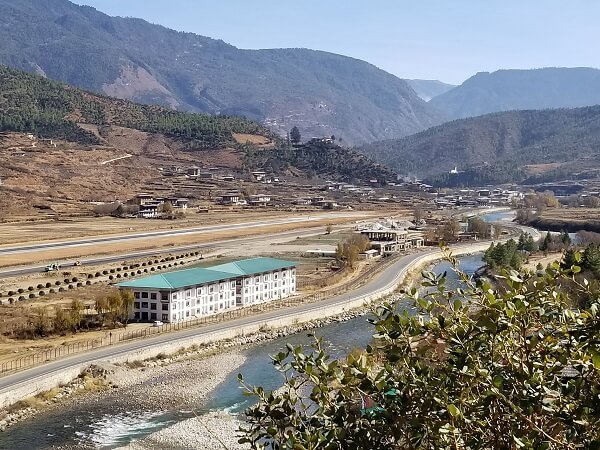
Paro has the country’s only international airport and is Bhutan’s gateway to the world. You can fly into Paro from Bagdogra, Bangkok, Calcutta, Delhi, Dhaka, Gaya, Guwahati, Kathmandu, Mumbai, and Singapore, and you can choose to fly out to another destination. You can also enter by land via Phuentsholing, Gelephu, and Samdrup Jongkhar.
Other than that, you’ll just need around $80 for your visa and payment processing fee and then however much you think you’ll need for tips and spending money (we’ll get to this later).
Our total cost for a 6-day/5-night trip in December 2017 was $1874 per person.
That’s $1150 per person for the low-season minimum daily package (including the $30 per person surcharge for our group of two), $659 for the flights from Kathmandu and out to Bangkok, and the visa and processing fees.
Last basic note: you don’t need to plan super far ahead. Our first email to our tour operator was less than two months before our trip.
How to choose an operator to visit Bhutan
There are more than 1,000 licensed tour guides in Bhutan. All speak English fluently (as do most Bhutanese) and many are proficient in other languages as well. And they work for the hundreds of licensed tour operators in Bhutan, the sheer number of which makes for a difficult decision when it comes to choosing one.
First and foremost, make sure you’re picking one of the licensed operators listed on the Tourism Council of Bhutan’s website. There have unfortunately been unlicensed operators popping up and taking advantage of visitors, breaking the law, and providing sub-par experiences.
Unless you have an immense amount of time on your hands, it’s impossible to objectively compare or even read reviews of all of the options. In my case, I googled for some ideas and also searched forums such as Lonely Planet to see which companies people had glowing words for. Then I shot off preliminary inquiries to each company to get an idea of how much things would cost and to see how many days they recommended given our interests and budgets.
Given that there’s no real cost difference due to the regulated minimum daily package, how you choose becomes very subjective. Ultimately I decided to go with the company that I felt the most comfortable communicating with.
And that’s how we ended up going with Blue Poppy Tour & Treks. While everyone I emailed with was very friendly, Blue Poppy was the quickest and most detailed in answering my many questions (which proved very useful later as we made many minor changes to our itinerary).
You can, of course, choose to go with a foreign travel agency that runs tours to Bhutan, but it’ll be more expensive and you’ll have to go with whatever itinerary they pick. Plus, who knows if you’ll like the folks on your tour?
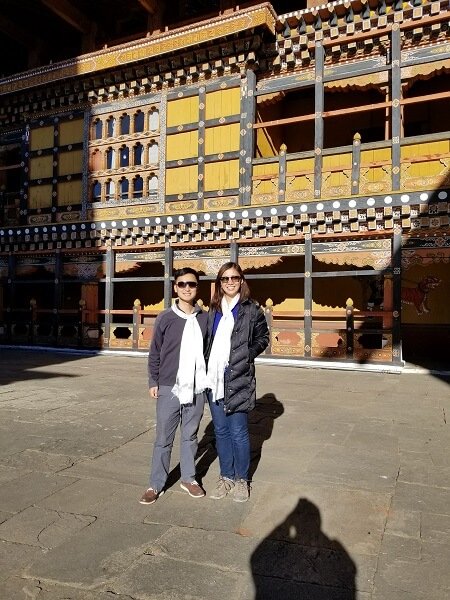
Customizing your Bhutan itinerary
One of the best things about this whole setup is that you get to customize your itinerary.
Of course, you’ll need to be considerate of how much time you have, how long it takes to get from city to city, and things like that, but generally, you can tell your tour operator what it is that you’re looking for in your visit to Bhutan.
I had decided to visit Bhutan on this funemployment trip when another friend on funemployment said it was on his wish list as well. Both being funemployed, we were conscious of our budgets but also wanted to make the most of our trip. After all, we were going to one of the most isolated nations in the world.
We agreed that Bhutan’s culture was our priority, and one of the components was attending one of Bhutan’s colorful and culturally-rich festivals. We let Blue Poppy know of our desires and they quickly came back with a proposed itinerary. Ultimately, we landed on a 6-day/5-night trip. After making a few date shifts, we were able to add the Dochula Druk Wangyel festival toward the end of our visit.
And that’s tip number one. If you’re prioritizing a cultural experience for your visit to Bhutan, make sure to include a festival. They’re absolutely otherworldly. Here are the tentative festival dates for 2018 and 2019.
I’ll let your tour operator give you the basics, as the main sightseeing spots are all the same, but here are a few more detailed tips to make your trip extra special.
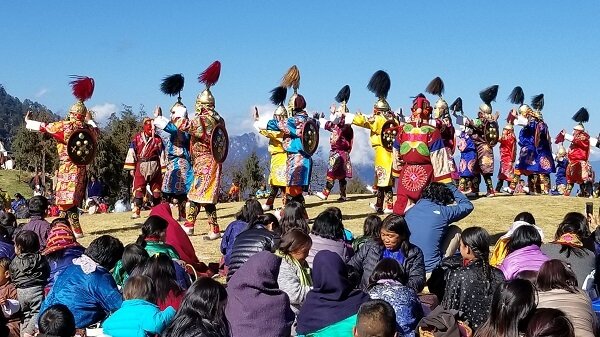
Tip number two is to request a trip to the National Post Office in Bhutan’s capital of Thimphu.
Not only can you find incredibly gorgeous postcards and greeting cards and a wealth of collectible stamps, you can also get custom stamps. With your photo.
Yep, you can get real, usable Bhutanese stamps with your face on it. I promise you everyone who gets mail from Bhutan from you will love it already, and they’ll be even more surprised when they see your face on the stamp.
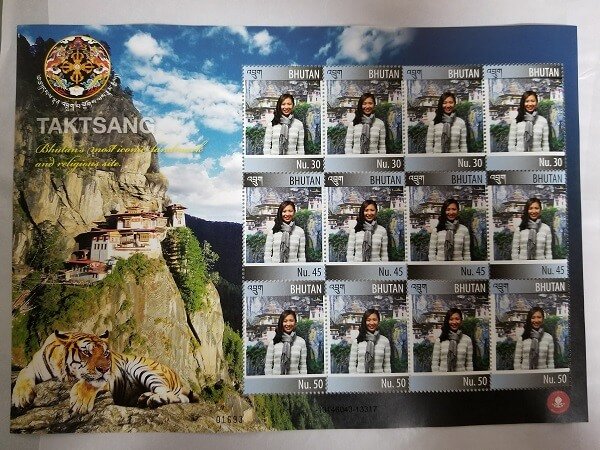
Tip number three: optimize your time in Bhutan and go for the earliest flight in and latest flight out. Remember the minimum daily package is calculated per night, so make the most of your first and last day.
Tip number four: make sure to include a farmhouse dinner or some other type of visit with locals.
If you’re doing a mostly city-based trip, you’ll be staying in hotels and eating in restaurants. While you’ll definitely have some interactions with locals here and there, it can’t compete with enjoying a homemade dinner with locals in their home.
Tip number five: pay the extra money for a hot stone bath.
This therapeutic and medicinal soak is an experience unique to Bhutan. Ours was an extra $25 and in a farmhouse shed, with members of the family we visited all chipping in to heat our stones and prep our baths. Other tour operators may charge much more, and experiences vary all the way to those in five-star resorts.
Tip number six: arrange to see an archery match.
It’s Bhutan’s national sport and their skills are phenomenal. We were fascinated at how adept they are, especially given we had a hard time even seeing where the target was while sitting near one end of the range.
Our tour operator, Blue Poppy, made it super flexible for us to make changes to our itinerary leading up to our trip. And it was possible for us to make smaller changes during the trip, provided we didn’t change the cities we were overnighting in.
What to pack for Bhutan
What you’ll need on your visit to Bhutan depends on your itinerary, but if you’re not trekking, you’ll mostly just need solid footwear and regular clothes that are appropriate for whichever season you’re visiting during.
Keep in mind that Bhutanese people must wear their national costume when entering places like the Paro dzong and the Tiger’s Nest (Taktshang monastery), and foreigners must wear pants or long skirts, long-sleeved shirts or short-sleeved ones with collars, and shoes that aren’t sandals or flip flops. For festivals, it is strongly suggested that you dress smartly and avoid wearing jeans and sneakers, though no one will kick you out if you do.
If you’re visiting during the winter like we did, it’s also important to bring thermal layers and a warm coat. (Here’s my packing list.) While the daytime temperatures were mild and around 50-60 degree Fahrenheit in December, it dipped into the 20s in the evenings and the hotels weren’t always super well-heated. (This was in western, central Bhutan. It will be much, much colder if you go north.)
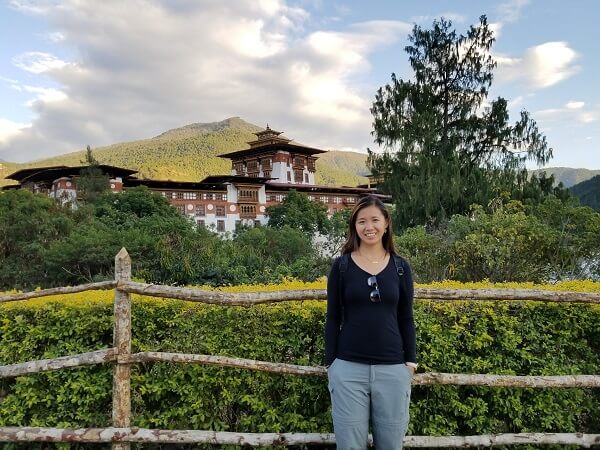
Electricity in Bhutan is at 230 V, 50 Hz, and most outlets are either two or three round pins. Find an adapter for India or Nepal and it should work in Bhutan as well. We only had basic electronics and thus no need for converters.
You’ll also want to bring money in US dollars, Euros, or British pounds. USD is preferred, and high denominations get the best conversion rates for the Bhutanese ngultrum, which you can only get inside Bhutan.
You can also use small denominations of Indian rupees, and some craft souvenir shops accept credit cards (Visa being the most commonly accepted). But in general, you’ll want to bring as much cash as you think you need. Even if you don’t expect to buy anything, remember to bring money for tips. And keep in mind that coffee, tea, juices, and such are typically free for breakfast but excluded for other meals; alcohol is always excluded.
We each exchanged USD150 and that was plenty. My friend spent all of his ngultrums while I had about $20’s worth left; most of our money went toward tips for our guide and our driver. (Unfortunately, the money exchange kiosk was closed the day we left, so yours truly spent roughly 1300 ngultrum on chocolate from the duty-free store in the Paro airport.)
What to expect when you’re in Bhutan
First, if you’re flying into Bhutan from Kathmandu, make sure to arrive at the airport at least three hours ahead of time so you can check in as early as possible.
You want to get one of the left-side window seats as it’ll give you a view of Mt. Everest (as such, it’s the right side on the way back to Kathmandu). Seating is only assigned at check-in and those coveted seats are first-come, first-serve. (Unfortunately, we were told two hours by our trip coordinator, and by the time we arrived, all those seats were taken.)
When you land in Bhutan, make sure to exchange your money before you get to immigration and exit through customs. I know this sounds odd, but this is where the money exchanger is, and it’s basically the only public exchange spot you have if you arrive on a weekend when banks are closed. (Some luxury hotels also do money exchange.)
I won’t say too much about what happens after you step outside of the airport terminal doors because I don’t want to take the magic out of your experience, but here’s a mishmash of things to know before you go:
- You’ll get a private welcome and pickup.
- If you’re offered tea upon arriving at a hotel, it’s typically free.
- The range of food served really varies, from places that serve western dishes and Indian and Chinese specialties while having no Bhutanese dishes to places that have a better balance. If you’re like me and really prefer having local food, you can ask your guide to call ahead of time to make sure a Bhutanese dish or two is prepared for you.
- On that, Bhutanese food is spicy! Spicy in a delicious but not unbearable way.
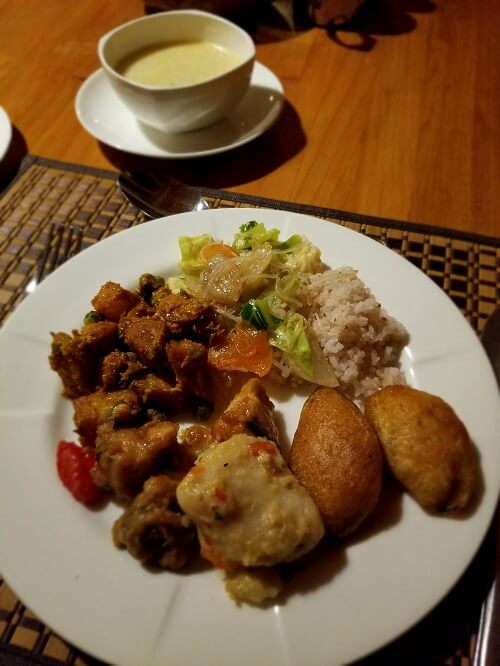
- They drive on the left-hand side.
- When visiting religious sites and turning prayer wheels, always move in a clockwise direction.
- Never take photos or videos inside temples, and never point at people or religious objects.
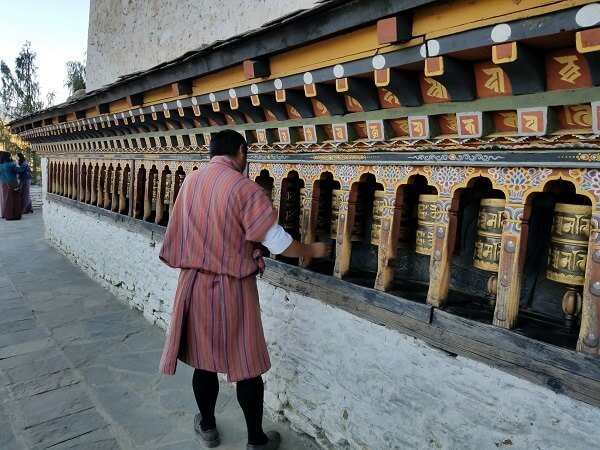
- If you are a smoker, keep in mind that the sale of tobacco is prohibited in Bhutan, and in some areas in the eastern part of the country, smoking is completely banned.
- Your cell signal likely won’t work in Bhutan, but if you have an unlocked phone, you can buy a B-Mobile network SIM card.
- Most hotels and restaurants have Wi-Fi, though it can be quite slow and sometimes spotty.
- The air you breathe is probably going to be the freshest air you’ve breathed in a long time.
What else do you want to know about visiting Bhutan? Feel free to ask in the comments and I’ll get back to you as soon as I can and to the best of my abilities.
Pin it to share it!
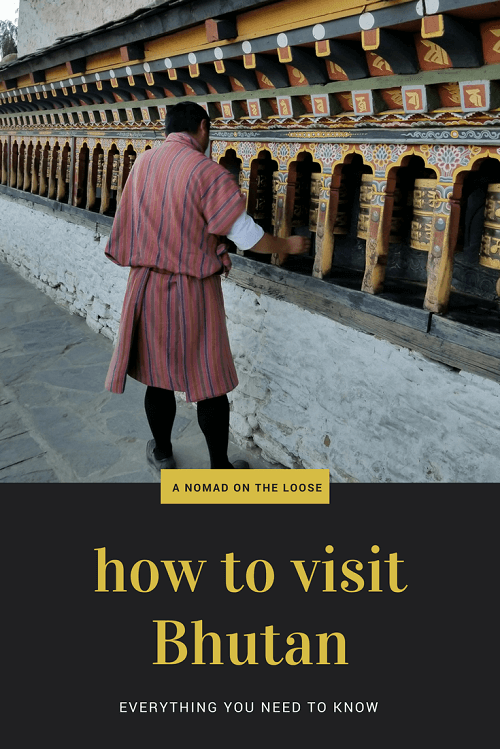

This is such an amazing, comprehensive guide! Thank you for all the tips! Bhutan is somewhere I’ve wanted to visit ever since we spent a week in Darjeeling and I realized how close it was. Still haven’t made it there, but will definitely be using your guide when I do!
Glad it’s helpful! So worth the trip, hope you make it there soon 🙂
Some really great tips! I have been seeing a lot of Bhutan tourism posts lately and it’s inspiring me to add Bhutan to my bucket list. I really do want to do the Tiger’s Nest hike as well ? Thanks for sharing all this information.
Yea it’s definitely getting more popular in the past 2 or so years. Go soon!
Bhutan is less than a 5 hr drive from my aunt’s place. As Indian citizens, fortunately, we don’t have to pay the USD 250 per night charge which is a relief! It’s truly a gorgeous country and the food is delicious!
So lucky! It’s the main thing keeping others away. Take advantage of it and enjoy!
There are many great tips here! Just last week I added Bhutan to my travel list. Seems like a beautiful place. Let’s see how I do without smoking over there…
Maybe it’s a good opportunity to quit 😉 Though technically in most of the western areas it’s legal and I did see people smoking. You just can’t buy it!
[…] Wanna know more about Bhutan? Check out What you need to know about Bhutan […]
[…] RELATED: HOW TO VISIT BHUTAN […]
[…] are known to have poor exchange rates but also because the cash I had on hand was meant for my trip to Bhutan, where our ATM cards don’t work at […]
[…] Wanna know more about Bhutan? Check out What you need to know about Bhutan […]